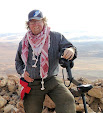 Though ruinous and much damaged by gold digging holes, the site is an impressive combination of central strongpoint and large walled enclosure. Early Islamic pottery has been found nearby and the fortification itself almost certainly has a medieval origin. We suspect it served and protected the traditional routeway of trade and pilgrimage dating back thousands of years, and that camel caravans may have overnighted inside the enclosure.
Though ruinous and much damaged by gold digging holes, the site is an impressive combination of central strongpoint and large walled enclosure. Early Islamic pottery has been found nearby and the fortification itself almost certainly has a medieval origin. We suspect it served and protected the traditional routeway of trade and pilgrimage dating back thousands of years, and that camel caravans may have overnighted inside the enclosure.


While our landscape archaeologist and two assistants produced a ground plan of the site, the rest of the team excavated a number of carefully targeted trenches designed to answer questions about the date and purpose of different parts of the complex. In one room of the central strongpoint we may have found the remains of the Ottoman cookhouse.

While all that was going on another team investigated two sites containing potential Ottoman soldier burials. After several hours excavation it became clear that while superficially interesting in the event no evidence supported the prior theory.
Subsequently the same team trekked up a previously unexplored ridge to the north north east of Batn Al Ghul station. This geographical feature would have been strategically important for observing any enemy approaching the station from this direction. No obvious military structures were found but it is likely that the fractured geology would have been used by a number of Ottoman observers to give advance warning of any oncoming enemy.






No comments:
Post a Comment